The transport system of Finland is well-developed. Factors affecting traffic include the sparse population and long distance between towns and cities, and the cold climate with waterways freezing and land covered in snow for winter.

VR-Group Plc, commonly known as VR, is a government-owned railway company in Finland. VR's most important function is the operation of Finland's passenger rail services with 250 long-distance and 800 commuter rail services every day. With 7,500 employees and net sales of €1,251 million in 2017, VR is one of the most significant operators in the Finnish public transport market area.
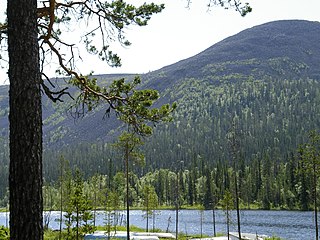
Kolari is a municipality of Finland at the Swedish border, which follows the Torne River, the longest free-flowing river in Europe.
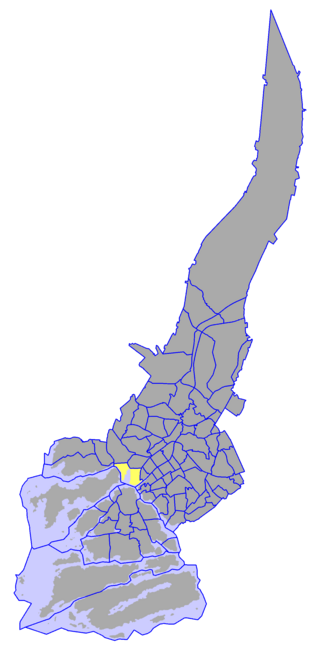
The Port of Turku is a port located in the south-west of Finland, where the mainland meets the beginning of the Turku archipelago. Sited within Finland's sixth largest city, the port principally handles traffic between Turku and the Swedish capital of Stockholm and the enclaved Åland.

The Finnish railway network consists of a total track length of 9,216 km (5,727 mi). The railways are built with a broad 1,524 mm track gauge, of which 3,249 km (2,019 mi) is electrified. Passenger trains are operated by the state-owned enterprise VR that runs services on 7,225 km (4,489 mi) of track. These services cover all major cities and many rural areas, though the coverage is less than the coverage provided by the bus services. Most passenger train services originate or terminate at Helsinki Central railway station, and a large proportion of the passenger rail network radiates out of Helsinki. VR also operates freight services. Maintenance and construction of the railway network itself is the responsibility of the Finnish Rail Administration, which is a part of the Finnish Transport Agency. The network consists of six areal centres, that manage the use and maintenance of the routes in co-operation. Cargo yards and large stations may have their own signalling systems.
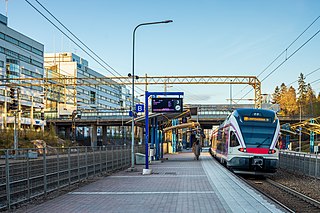
Käpylä (Finnish) or Kottby (Swedish) is a railway station in the Käpylä district of Helsinki, Finland. It is located between the stations of Pasila and Oulunkylä, along the main railroad track from Helsinki to Riihimäki, about 6 km north from the Helsinki Central railway station.

Oulunkylä railway station is a railway station in the Oulunkylä district of Helsinki, Finland. It is located between the stations of Käpylä and Pukinmäki, along the main railroad track from Helsinki to Riihimäki, about 7 kilometres (4 mi) north of the Helsinki Central railway station.
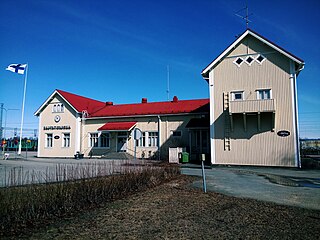
Kemi railway station is located in the town of Kemi in the Lapland Province of Finland. It is operated by VR. The distance to the Helsinki Central railway station, via Haapamäki and Oulu stations is 858.3 kilometres.

The Karkku railway station is located in the village of Karkku in the town of Sastamala, Finland. The station is located about 43 kilometres from the Tampere railway station and about 92 kilometres from the Pori railway station. Nowadays, the station is unmanned, and the track is controlled remotely from Tampere. The station is served by all InterCity trains that travel between Tampere and Pori.

The Varkaus railway station is located in the town of Varkaus, Finland, in the province of Northern Savonia. The distance from the Helsinki Central railway station is 424.7 kilometres, via the Pieksämäki and Kouvola stations. By rail, the distance to Pieksämäki is 49 kilometres (30 mi) and to Joensuu 133 kilometres (83 mi). All passenger trains from Pieksämäki to Joensuu stop at Varkaus, and the station also has cargo traffic.

Kolari railway station is located in the municipality of Kolari in the Lapland region of Finland. It is the northernmost railway station in Finland, located 800 km (500 mi) north of Helsinki Central railway station. The railway track extends 18 kilometres further north to the Rautuvaara railway yard but the section between Kolari and Rautuvaara is disused.

Oitti railway station is a railway station in the village of Oitti in the municipality of Hausjärvi, Finland. The station is located along the Riihimäki–Lahti line, approximately 15 kilometres (9 mi) away from Riihimäki railway station and approximately 44 kilometres (27 mi) from Lahti railway station.
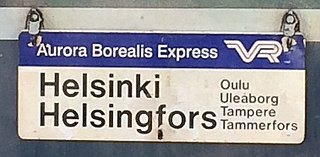
The Aurora Borealis Express is an overnight express train operating between Helsinki and Kolari in Finland. The train travels via many major cities and towns in Finland, and stops at most of them. The total distance is a little under 1000 kilometers, and lasts for 14½ hours to 16 hours depending on direction and season. The service is bi-directional, with a corresponding train operating southwards over the same route.

The Hikiä railway station is located in Hausjärvi, Finland, in the village and urban area of Hikiä. It is located along the Riihimäki–Lahti line, and its neighboring stations are Riihimäki in the west and Oitti in the east.

The Mommila railway station is located in Hausjärvi, Finland, in the village of Mommila. It is located along the Riihimäki–Lahti line, and its neighboring stations are Oitti in the west and Lappila in the east.
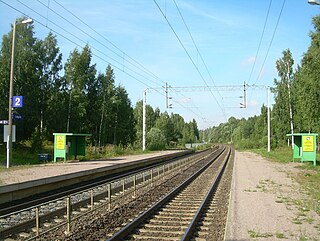
The Lappila railway station is located in Kärkölä, Finland, in the village and urban area of Lappila. It is located along the Riihimäki–Lahti line, and its neighboring stations are Mommila in the west and Järvelä in the east.
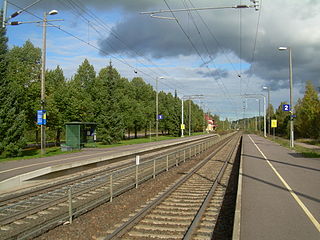
The Herrala railway station is located in Hollola, Finland, in the village and urban area of Herrala. It is located along the Riihimäki–Lahti line, and its neighboring stations are Järvelä in the west and Lahti in the east.

The Uusikylä railway station is located in the city of Lahti, Finland, in the district of Uusikylä. It is located along the Lahti–Kouvola line, and its neighboring stations are Nastola in the west and Kausala in the east.

Henna railway station is located in the town of Orimattila, Finland, in the district of Henna. It is located along the Kerava–Lahti railway, and its neighboring stations are Lahti in the north and Mäntsälä in the south.
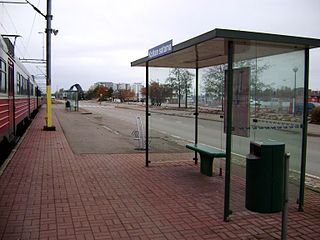
The Kotka Port railway station is located in the town of Kotka, Finland, right by its namesake, the Kotka ferry terminal.



















